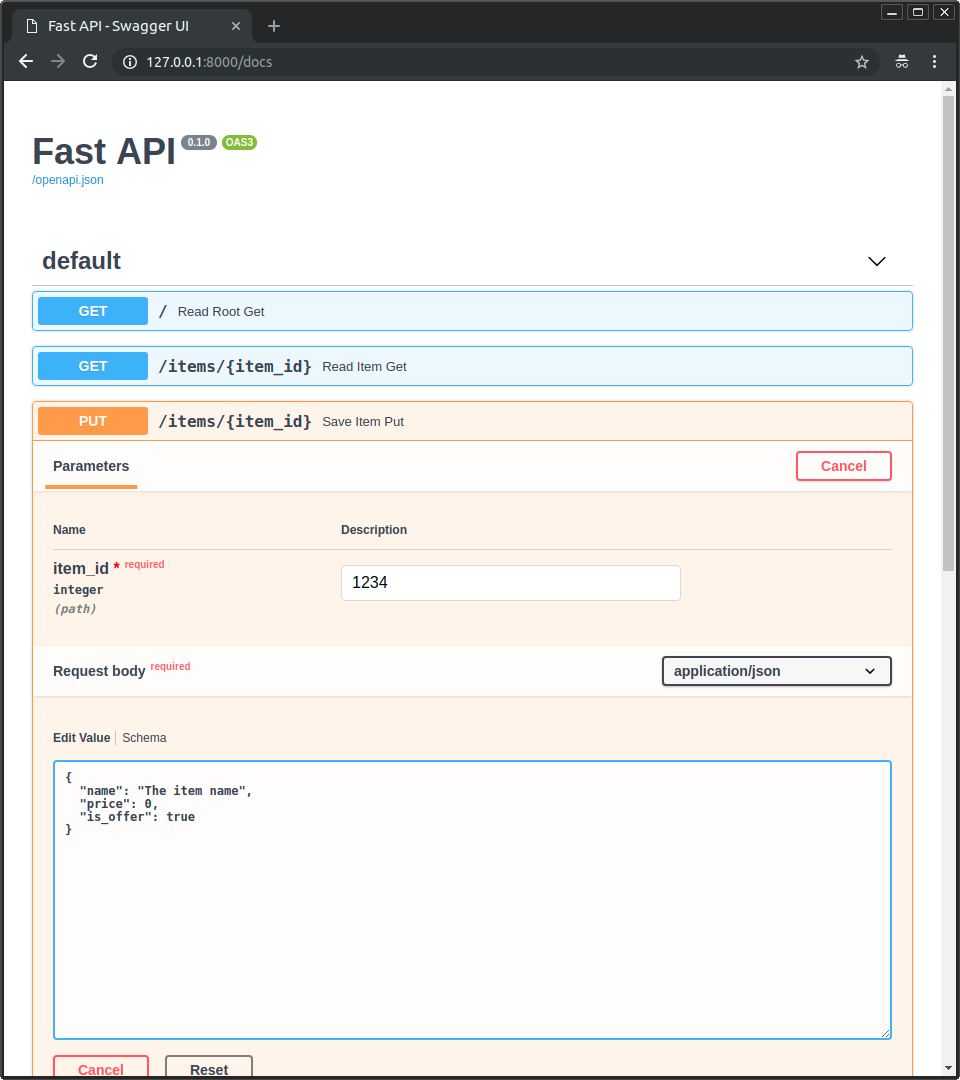- Sort Score
- Result 10 results
- Languages All
Results 31 - 40 of 125 for Try (0.12 sec)
-
docs/zh/docs/index.md
* 交互式 API 文档将会自动更新,并加入新的请求体:  * 点击「Try it out」按钮,之后你可以填写参数并直接调用 API:  * 然后点击「Execute」按钮,用户界面将会和 API 进行通信,发送参数,获取结果并在屏幕上展示:
Plain Text - Registered: Sun May 05 07:19:11 GMT 2024 - Last Modified: Mon Apr 29 05:18:04 GMT 2024 - 18.2K bytes - Viewed (0) -
docs/em/docs/how-to/custom-request-and-route.md
✋️ 👉 🖼 ☑ & ⚫️ 🎦 ❔ 🔗 ⏮️ 🔗 🦲. 👥 💪 ⚙️ 👉 🎏 🎯 🔐 📨 💪 ⚠ 🐕🦺. 🌐 👥 💪 🍵 📨 🔘 `try`/`except` 🍫: ```Python hl_lines="13 15" {!../../../docs_src/custom_request_and_route/tutorial002.py!} ``` 🚥 ⚠ 📉, `Request` 👐 🔜 ↔, 👥 💪 ✍ & ⚒ ⚙️ 📨 💪 🕐❔ 🚚 ❌: ```Python hl_lines="16-18"Plain Text - Registered: Sun May 05 07:19:11 GMT 2024 - Last Modified: Thu Apr 18 19:53:19 GMT 2024 - 3.6K bytes - Viewed (0) -
docs/en/docs/tutorial/metadata.md
* `description`: a `str` with a short description for the external docs. * `url` (**required**): a `str` with the URL for the external documentation. ### Create metadata for tags Let's try that in an example with tags for `users` and `items`. Create metadata for your tags and pass it to the `openapi_tags` parameter: ```Python hl_lines="3-16 18" {!../../../docs_src/metadata/tutorial004.py!} ```Plain Text - Registered: Sun May 05 07:19:11 GMT 2024 - Last Modified: Sun Mar 31 23:52:53 GMT 2024 - 5.8K bytes - Viewed (0) -
docs/en/docs/python-types.md
But then you have to call "that method that converts the first letter to upper case". Was it `upper`? Was it `uppercase`? `first_uppercase`? `capitalize`? Then, you try with the old programmer's friend, editor autocompletion. You type the first parameter of the function, `first_name`, then a dot (`.`) and then hit `Ctrl+Space` to trigger the completion. But, sadly, you get nothing useful:
Plain Text - Registered: Sun May 05 07:19:11 GMT 2024 - Last Modified: Thu Apr 18 19:53:19 GMT 2024 - 17K bytes - Viewed (0) -
pyproject.toml
"--strict-markers", "--ignore=docs_src", ] xfail_strict = true junit_family = "xunit2" filterwarnings = [ "error", # TODO: needed by asyncio in Python 3.9.7 https://bugs.python.org/issue45097, try to remove on 3.9.8 'ignore:The loop argument is deprecated since Python 3\.8, and scheduled for removal in Python 3\.10:DeprecationWarning:asyncio',
Plain Text - Registered: Sun May 05 07:19:11 GMT 2024 - Last Modified: Thu May 02 22:37:31 GMT 2024 - 9.3K bytes - Viewed (0) -
docs/en/docs/tutorial/security/first-steps.md
You don't even have to check if the token exists to return an error. You can be sure that if your function is executed, it will have a `str` in that token. You can try it already in the interactive docs: <img src="/img/tutorial/security/image03.png"> We are not verifying the validity of the token yet, but that's a start already. ## Recap
Plain Text - Registered: Sun May 05 07:19:11 GMT 2024 - Last Modified: Wed Mar 13 19:02:19 GMT 2024 - 8.9K bytes - Viewed (0) -
docs/en/docs/deployment/https.md
Only one process can be handling the specific IP and port (the TLS Termination Proxy in our example) but the other applications/processes can be running on the server(s) too, as long as they don't try to use the same **combination of public IP and port**. <img src="/img/deployment/https/https08.svg">
Plain Text - Registered: Sun May 05 07:19:11 GMT 2024 - Last Modified: Thu Jan 11 16:31:18 GMT 2024 - 12K bytes - Viewed (0) -
docs/en/docs/tutorial/security/oauth2-jwt.md
But you cannot convert from the gibberish back to the password. ### Why use password hashing If your database is stolen, the thief won't have your users' plaintext passwords, only the hashes. So, the thief won't be able to try to use that password in another system (as many users use the same password everywhere, this would be dangerous). ## Install `passlib` PassLib is a great Python package to handle password hashes.
Plain Text - Registered: Sun May 05 07:19:11 GMT 2024 - Last Modified: Thu Apr 18 19:53:19 GMT 2024 - 13K bytes - Viewed (0) -
docs_src/dependencies/tutorial008_an_py39.py
from typing import Annotated from fastapi import Depends async def dependency_a(): dep_a = generate_dep_a() try: yield dep_a finally: dep_a.close() async def dependency_b(dep_a: Annotated[DepA, Depends(dependency_a)]): dep_b = generate_dep_b() try: yield dep_b finally: dep_b.close(dep_a)
Python - Registered: Sun May 05 07:19:11 GMT 2024 - Last Modified: Sat Mar 18 12:29:59 GMT 2023 - 521 bytes - Viewed (0) -
docs/em/docs/tutorial/sql-databases.md
``` === "🐍 3️⃣.9️⃣ & 🔛" ```Python hl_lines="13-18" {!> ../../../docs_src/sql_databases/sql_app_py39/main.py!} ``` !!! info 👥 🚮 🏗 `SessionLocal()` & 🚚 📨 `try` 🍫. & ⤴️ 👥 🔐 ⚫️ `finally` 🍫. 👉 🌌 👥 ⚒ 💭 💽 🎉 🕧 📪 ⏮️ 📨. 🚥 📤 ⚠ ⏪ 🏭 📨.Plain Text - Registered: Sun May 05 07:19:11 GMT 2024 - Last Modified: Thu Apr 18 19:53:19 GMT 2024 - 25.2K bytes - Viewed (1)